Menus
- 3.5 seconds faster *!
- * Than the Pilot Power 3 tire according to Michelin
- Best in the dry
- ACT technology+
- Silica and carbon black
- And the front?
- 3 seconds faster in the wet too!
- And more enduring with it!
- Whaaooo!
- For the little ones too!
- Available sizes:
3.5 seconds faster *!
* Than the Pilot Power 3 tire according to Michelin
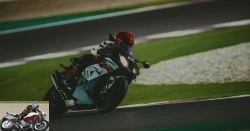
"There will be a before and an after" announces David Jean, the sales manager, all smiles, at a press conference. For once in Clermont Ferrand we put the package. Here we are all embarked in Qatar to discover their new baby on a dry track. Because indeed, it is in this area that the Power RS claims the biggest gain. No less than 3.5 seconds on average on a time lap in Cartagène, Fontange and Ladoux compared to the old Pilot Power 3. A heading, a peak, what am I saying, a peninsula … Enough to position the new nose (…) at the top of its category. Its category is precisely the hypersport road. Although presented on the circuit, it is a road tire that we have to deal with. Its closest competitors are therefore the Dunlop Sportsmart 2, the Metzeler Sportec M7 RR, the Pirelli Diablo Rosso 3 and the Continental Sport Attack 3. A nice skewer that the Power RS would have outclassed in all areas, including the chrono, according to a comparison conducted by Motorrad Test Center and Dekra. Only absent, the Dunlop Sportmart2 Max, which was not yet available at that time. Too bad, we would have gladly put these two face to face! In short, to celebrate the thirtieth anniversary of the first production radial tire (A59 and M59 X) Michelin has concocted a bombshell for us!
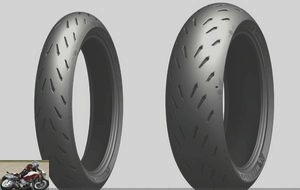
Best in the dry
We know the DNA of the Clermont-Ferrand manufacturer, champion in the rain, but we have often observed that in the field of road sports tires, this advantage translates into a relative weakness of the tire when hot on the track, with a tendency to collapse. under very high stress (track + heat). It is therefore precisely this axis that the engineers worked on. The idea was to get more grip in the dry, more stability and more agility. To achieve this, it took two years of fundamental research, then two more years of development accompanied by the filing of 2 patents for a new technology called ACT.+.
ACT technology+
The principle consists of reinforcing the carcass on the sides to obtain stiffness in bends, synonymous with stability, and on the contrary to soften it at the top to obtain stability, but in a straight line this time. It is by turning the ends of the ply in the sidewalls, without them going up to the top of the tire that they have succeeded. Basically, it’s like the tire has one patch at the top and two on the sidewalls. In addition, and this is part of the patents, on the sides, the layers are slightly crossed, which gives rigidity by a phenomenon of triangulation. However, the crossing angles remain low (75 to 80 ° instead of 90 °) which does not make the Power RS a diagonal tire. ACT + therefore allows the Power RS to withstand the constraints, powers and speeds of large hypersport.
Silica and carbon black
On the rubber side, there are conventionally two different mixtures, one based on silica for grip in wet conditions and wear, in the center and as an undercoat on the sidewalls and the other dedicated exclusively to dry grip, located on the sides. sides, on the strong corner sockets, based on carbon black. New mixtures developed in-house by the group’s chemistry department.
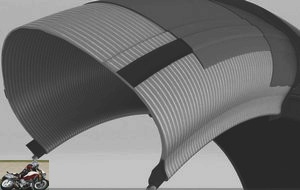
And the front?
He is not left out either because for agility in particular, he is the one who plays the biggest role. To achieve their objective, the Michelin engineers modified the front profile … But inside! The idea was not to change the shape of the tire, but its "response" to the demands. By changing the internal profile, more thickness on the sides, less on the sidewalls, they modify the rigidity of the tire and therefore the forces transmitted to the handlebars, as well as the feedback to the rider. There you have it, you know almost everything about this new tire which promises us so much in the dry. But by the way and the wet? Because it’s a Michelin all the same!
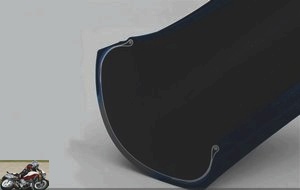
3 seconds faster in the wet too!
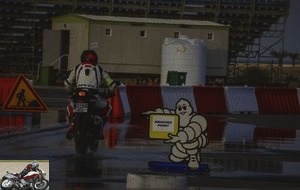
Despite a very low notching rate (8 to 8.5% in front and only 6.5% behind) the Power RS also explodes the stopwatch in the rain and especially in cold weather (10 °). On the watered Michelin track (1.08 ‘per lap) it largely deposits its predecessor. If the temperature rises, the gap melts at 1 second, but clearly the more it slides the better. Remember that the Power 3 was already not a handle in the wet. The secret, in addition to the properties already explained, is the position of the notches, just in the 25/35 ° zone that you never exceed in the rain. The tire is more "slick" before and after, but not where it counts when riding in the wet.

And more enduring with it!
All these developments have made it possible to improve the longevity of the tire, which, according to an independent test carried out by Dekra, manages to cover an average kilometer 25% higher than the best of its competitors! Faster in the dry and in the wet, according to Michelin, but based on independent testing, this new Power RS seems to be squaring the circle. What if we try it?
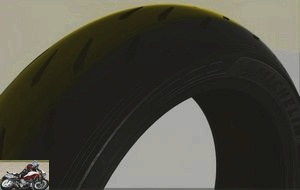
Whaaooo!
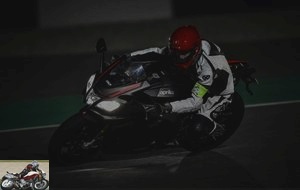
There is something intimidating about discovering the Losail route. First of all, the world leaders just do battle. Then, we drive at night, but as in broad daylight thanks to a lighting as incredible as it consumes. In fact, we feel a bit ridiculous and the track is both very wide and not easy to remember. Difficult to find its marks. We start with three warm-up laps with Pilot Power 3 to get in the mood and remember the behavior of the old one. Then we take the same bike for 3 more laps in Power RS. Whaooo! The difference is enormous, almost disconcerting. The bike moves a lot less, but above all it is so easy to register in turns that we are surprised. We have the impression of having changed motorbikes, just by changing tires! Riding the state-of-the-art S 1000 RR, I’m paddling a bit to assimilate all these differences, so for the first of three 20-minute sessions we’ll have, I’m going for an easier Aprilia RSV4. Jean-François Cortinovis, instructor pilot, took the opportunity to show me the trajectories. So, riding the beautiful Italian, I gain confidence. The driving is instinctive, easy and not at all disconcerting anymore … Until a gas failure puts an end to the merry-go-round.
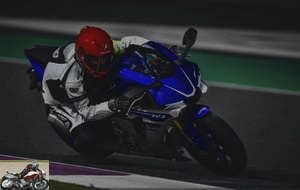
For the second session I get on an R1. "You brake at the first stroke and then you see if you can push back further" JF told me. Ok, I’m trying, but I’m scared. I take a look at the speedometer before taking the brakes, it reads 298 km / h. Hat’s Off! I grab the brakes and indeed, it passes, but I will not have the courage to look for a mark further !. In the meantime, I see that the stability, at high speed as in braking, is imperative. For my last series, I am using an S1000RR. This fury rises with each acceleration and we arrive even faster under braking. The eyes pop out of my head, but the ABS does not fire, despite the tires tired by 6 sets of 20 minutes (we alternate with another group of journalists). Traction control flashes more often, but the bike remains healthy, especially for a road tire!
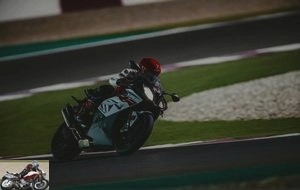
For the little ones too!
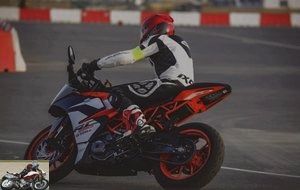
So really nice and promising this Power "Renn Sport" as our German friends say. To validate its daily behavior, we will test one soon on the road. Finally, the last good news, there is also for small displacement, without ACT + technology at the rear, because given the levels of power and speed, it is not justified. We tested it quickly on a KTM 390 with great pleasure. To console you for the absence of ACT +, note that in this version intended for daily use, Michelin has placed even more emphasis on wet grip. You can do lap times by going to work, to college, or to high school, even in winter! In the meantime, we can not wait to test the Power RS, "in real life", just to validate all its promises..
Strong points
- Maneuverability
- High speed and braking stability.
- Grip level on dry ground
- Confidence
- Promising technologies
- Small dimensions … and very large!!
Weak points
-
Not tested on wet ground
Test conditions
- Itinerary: Losail Circuit near Doha, Qatar
- Temperature 26 ° temperature of track 28 at the start of the test, 24 at the end (night test)
- Motorcycle mileage: –
- Encountered problem : –
In practice: immediate availability
- The PILOT POWER RS replaces the Pilot Power 3 and the Pilot Power supersport evo.
- The Pilot Power 3 remains however in "second line", at a lower price.
- price noted on the net: 257 € excluding installation and balancing in 120/180 X 17
Available sizes:
- front: 110/70 R and ZR 17 120/60 and 70 ZR 17
- Rear 140/70 R 17; 150/60 ZR 17; 160/60 ZR 17; 180/55 ZR 17; 180/60 ZR17; 190/50 ZR 17; 190/55 ZR 17; 200/55 ZR 17; 240/45 ZR 17
Related articles
-
The sport / hypersport tire that wants to reconcile road, track and longevity Dunlop made a strong comeback to the top of the road market in 2007 with…
-
Bibendum takes care of its line for its dual-compound sport tire Michelin has just presented its brand new tire, the Michelin Power Pure, on the Almeria…
-
Metzeler Sportec M9 RR tire test
Sporty road tire The top of the pure road range in terms of sales and performance, the M7 RR tire is almost a monument as it is crowned with victories in…
-
Operation Seduction II The journalists troop follow in the footsteps of opener Dunlop and leave Ajaccio on a 4-lane section with fast corners. Not…
-
Metzeler Sportec M7 RR tire test
A champion tire in the rain Eager to have us try out his hypersport tire in sunny Almeria, Metzeler had planned a “spin” program based on S 1000 RR 2015….
-
Bridgestone Battlax Hypersport S22 motorcycle tire test
The street racing tire according to Bridgestone The successor of the S21, the new hypersport road tire from Bridgestone is called S22. We discovered him…
-
The fifth element in 3D version A scent of competition for the tire of Clermont, which succeeds the Pilot Road 4 The Road5 is the brand new Michelin tire…
-
Michelin PilotPower3 tire test
On test: PilotPower3: 85% road, 15% track 100% attack Fresh out of the oven, the Michelin Pilot Power 3 replaces the Power Pure. It’s a hypersport tire…
-
Pirelli Diablo Rosso II tire test
The successor of the diablo Rosso enters the era of the bi-eraser The days of the diablo Rosso are numbered. After 3 years of existence, he will…
-
Continental Road Attack 3 tire test
More grip in the rain and more durability: the best of both worlds ? Daily, walks and road rally: a tire tested over 6,500 km Continental has developed…
@ Jean34480:
Before the 1000 Africa Twin I had a BMW GS LC model 2014 and it is true that with the original suspensions, I found the Honda less rigorous than the GS, in particular as a duo because the rear spring is clearly too much low for two people of normal weight.On the other hand, replacing the rear spring leaves a Hyperpro spring (in +20 mm in my case) that changes everything (for less than 100 €), especially if we also adjust the front fork a little firmer and more cushioned: with that the bike becomes precise, rigorous, and you can ride about as fast as with the GS in safety.
As for consumption and autonomy, I do not agree with you at all because I find that the Honda consumes very little, about 0.5 liters less than the GS LC (however not very greedy) and that the range is water less 350 km in duo (sometimes even 400 km) while driving at a very good pace. Of course it’s still a little better solo, even if you increase the pace. For me, almost 400 km is quite enough !
I soon have 6000 km with the Honda and I like it more and more: it is a very comfortable machine, which holds the road well (by changing the original tires) and its engine, associated with a DCT gearbox makes wonder: it may be less potato in times than that of the GS LC if you stay in sixth or even fifth but, with the DCT box, dropping one or two gear is a pleasure and the pickups become particularly effective. I don’t feel any lack of power or torque compared to my previous GS LC and I have plenty more than I need.
Franck